
The Pseudo-Simons is the notname given to a painter presumed to have been active in Antwerp during the second half of the 17th century and attributed with around100 works, principally of fruit and flower still lifes as well as pronkstillevens. [1]

The Pseudo-Simons is the notname given to a painter presumed to have been active in Antwerp during the second half of the 17th century and attributed with around100 works, principally of fruit and flower still lifes as well as pronkstillevens. [1]

The notname of this artist was given by Fred Meijer of the Netherlands Institute for Art History after he grouped a body of about 100 works he considered likely to be of common origin. During the 20th century, these works been attributed to the Dutch still-life painter Michiel Simons (fl. 1648–1673). The attribution to Simons was based the works' stylistic similarities to the work of Jan Davidszoon de Heem, Ambrosius Bosschaert II and Johannes Bosschaert II. These three artists, like Simons, had all worked in Utrecht, Netherlands. [2]
Meijer found that the style was closer to that of Flemish still-life painters of the second half of the 17th century such as Jan Pauwel Gillemans the Elder and Jan Pauwel Gillemans the Younger, concluding that the artist must have must have been familiar with their work. The artist was named the "Pseudo-Simons" due to the erroneous attribution to Simons. [3]
It is believed that this anonymous artist worked in Antwerp some time between 1650 and 1680. He also may have worked in England, which would account for the early presence of his works in English collections. [1] [ vague ]

About 100 works have been attributed to the Pseudo-Simons. [4] None of the works are signed. [2] These works are principally fruit still lifes, along with some flower still lifes and pronkstillevens (sumptuous still lifes of luxurious objects). [1] His style and subjects show the influence of his contemporary Flemish painters. [2]

Adriaen van Utrecht was a Flemish painter known mainly for his sumptuous banquet still lifes, game and fruit still lifes, fruit garlands, market and kitchen scenes and depictions of live poultry in farmyards. His paintings, especially the hunting and game pieces, show the influence of Frans Snyders. The two artists are considered the main inventors of the genre of the pronkstillevens, i.e. still lifes that emphasized abundance by depicting a diversity of objects, fruits, flowers and dead game, often together with living people and animals. Van Utrecht also painted a number of flower still lifes. He was a regular collaborator with leading Antwerp painters who had been pupils or assistants of Peter Paul Rubens, such as Jacob Jordaens, David Teniers the Younger, Erasmus Quellinus II, Gerard Seghers, Theodoor Rombouts, Abraham van Diepenbeeck and Thomas Willeboirts Bosschaert.
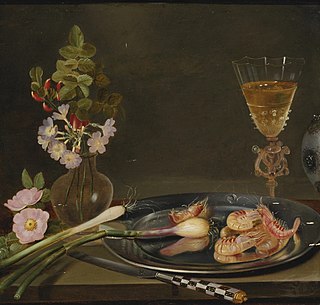
Frans Ykens was a Flemish still life painter active in Antwerp and Brussels in the 17th century. He is mainly known for his flower pieces and fruit still lifes and also painted banquet pieces, pronkstillevens, garland paintings and larger game pieces.

Jan van Kessel the Younger or Jan van Kessel II, known in Spain as Juan Vanchesel el Mozo or el Joven, was a Flemish painter who after training in Antwerp worked in Spain. Known mainly for his portraits he became a court painter to the King and Queen of Spain. A few landscapes and mythological and allegorical scenes have also been attributed to him. He was formerly believed to have been active as a landscape painter, but this is now no longer generally accepted.

Pieter Thijs, Peter Thijs or Pieter Thys was a Flemish painter of portraits as well as religious and history paintings. He was a very successful artist who worked for the courts in Brussels and The Hague as well as for many religious institutions. His work was close to the courtly and elegant style of Anthony van Dyck and his followers.
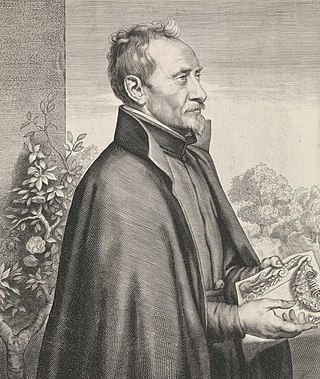
Daniel Seghers was a Flemish Jesuit brother and painter who specialized in flower still lifes. He is particularly well known for his contributions to the genre of flower garland painting. His paintings were collected enthusiastically by aristocratic patrons and he had numerous followers and imitators.
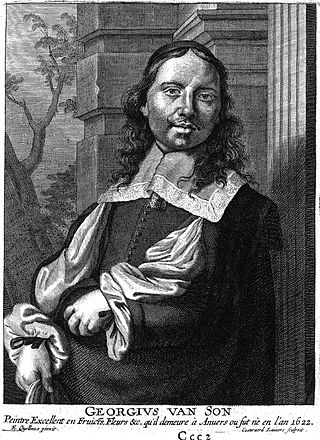
Joris van Son or Georg van Son was a Flemish still life painter who worked in a number of sub-genres but is principally known for his still lifes of fruit. He also painted flowers, banquets, vanitas still lifes and pronkstillevens. He is known to have painted fish still lifes representing the Four Elements, and also collaborated with figure artists on 'garland paintings', which typically represent a devotional image framed by a fruit or flower garland.

Carstian Luyckx, also known as the Monogrammist KL, was a Flemish painter and draughtsman who specialized in still lifes in various subgenres including flower still lifes, fruit still lifes, fish still lifes, pronkstillevens, vanitas still lifes, hunting pieces and garland paintings. He also painted animals and a few genre scenes. After starting his career in Antwerp he is believed to have worked later in France.
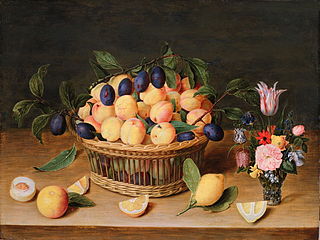
Jacob van Hulsdonck or Jan van Hulsdonck, was a Flemish painter who played a role in the early development of the genre of still lifes of fruit, banquets and flowers.

Jan Pauwel Gillemans the Elder was a Flemish goldsmith and still life painter who is known for his fruit still lifes, flower pieces, vanitas still lifes and pronkstillevens.

Jan Pauwel Gillemans the Younger was a Flemish still life painter. He worked in a range of still life genres including flower and fruit still lifes, banquet still lifes, pronkstillevens and hunting pieces. He collaborated with figure painters to create landscapes which combined a mythological or allegorical scene with a still life. He worked and lived in Antwerp, Middelburg, London and Amsterdam.

Jan Frans van Son or Frans van Son was a Flemish still life painter. The son of the prominent Antwerp still life painter Joris van Son, he trained with another prominent still life artist Jan Pauwel Gillemans the Elder. He left for England at a young age and had a successful career in London. He painted flower pieces, fruit still lifes and banquet still lifes.

Jan Baptist Bosschaert or Jan Baptist Bosschaert the Younger was a Flemish still life painter who is principally known for his decorative still lifes with flowers. He collaborated with figure artists on compositions which combined allegorical or mythological scenes with a still life element. He was active in Antwerp.

Gaspar Peeter Verbruggen or Gasparo Pedro Verbruggen was a Flemish still life painter who is principally known for his decorative still lifes with flowers and fruit. He collaborated with figure artists on compositions which combined figures with a still life element. He was active in Antwerp and The Hague.
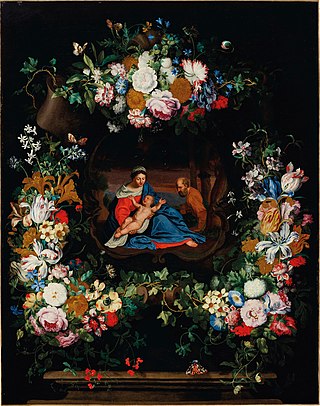
Jan Pieter Brueghel or Jan Peeter Brueghel was a Flemish painter who specialised in flower still lifes and garland paintings. A scion of the famous Brueghel family of painters, he trained in Antwerp with his father and later worked in Liège, Paris and Italy.
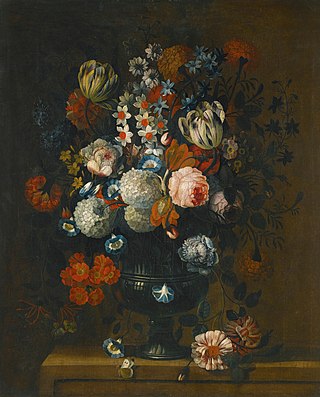
Simon Hardimé (1672–1737) was a Flemish painter of mixed Walloon and Flemish descent. He is known for his paintings of flowers. He trained in Antwerp and later worked for a few years in the Dutch Republic. He then moved to London where he remained the rest of his life. His patrons included the bourgeoisie in Brussels and Antwerp and aristocrats in the Netherlands and England.
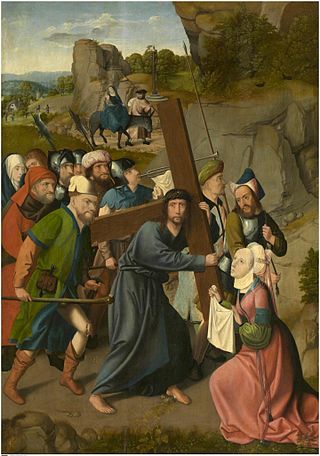
The Master of Hoogstraeten is the Notname given to a Flemish painter or a collective of painters active in Antwerp in the early 16th century. The master created principally religious paintings and is considered a member of the Antwerp Mannerists.
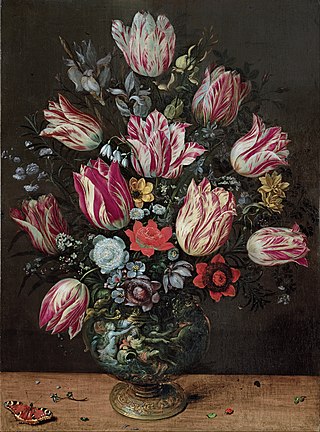
Andries Daniels was a Flemish painter who was active in Antwerp during the first half of the 17th century. He is known for his flower still lifes and garland paintings, a genre of still life paintings that he helped develop in Antwerp.
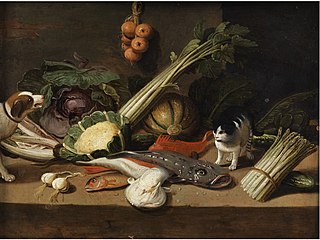
Pseudo-Jan van Kessel the Younger or Pseudo-Jan van Kessel the (II) is the notname given to an artist or workshop to whom or which are attributed about 200 small still lifes likely dating to the late 16th and early 17th century. The artist's works rely on combinations of a limited number of motifs in rather simple to quite elaborate compositions. The motifs in the paintings are rendered in a rather naive and decorative manner. While the Flemish influence in the works hints at a Flemish artist or an artist who trained with a Flemish artist, the artist is believed to have been active in southern Europe, probably Italy.

Pieter Hardimé was a Flemish painter known for his paintings of flowers. He trained in Antwerp and later moved to the Dutch Republic where he worked in The Hague. He was active as a decorative painter of flowers for wall and ceiling decorations, often in collaboration with Mattheus Terwesten.

W. Mertens, known also as Wouter Mertens was a Flemish still life painter active in Antwerp who is known for his fruit still lifes and pronkstillevens. His work shows the influence of Jan Davidszoon de Heem, a Dutch still life painter who was active in Antwerp from the mid-1630s.